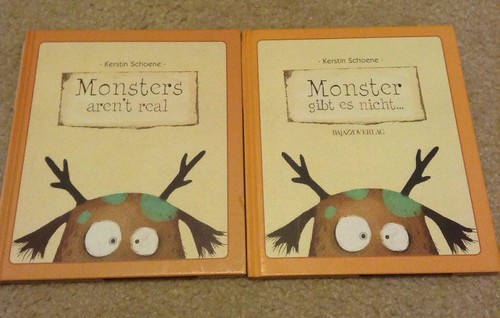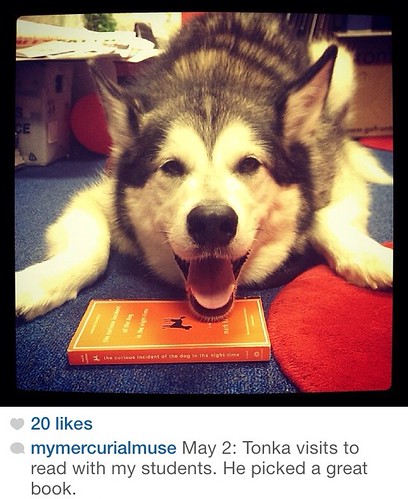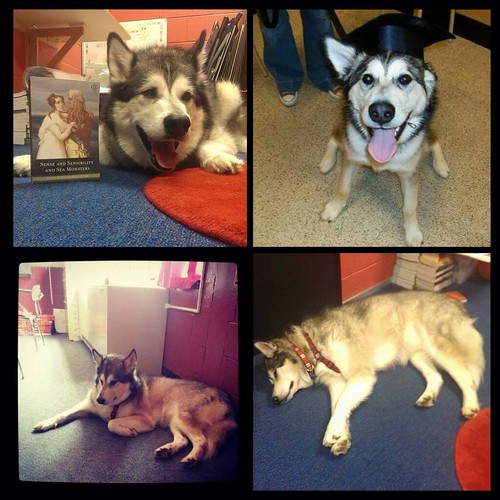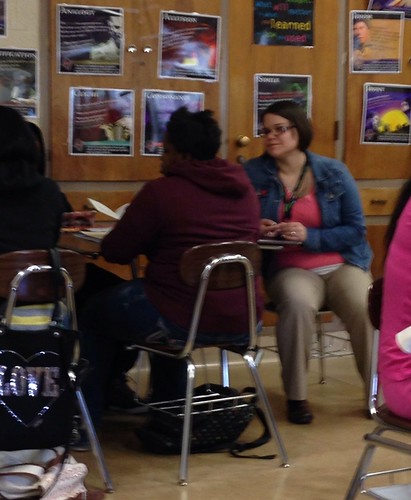Sunday, May 25, 2014
May 2014 #nctechat Storify on Summer Reading
Last Sunday, May 18, Donalyn Miller and Kelly Gallagher hosted #nctechat where the topic was summer reading. There were so many great resources and tweets from this chat that I wanted to compile all of my favorites in a Storify.
Saturday, May 24, 2014
Existentialism on a Weeknight
 A few nights ago my husband read me the original German version of Monsters Aren't Real (i.e., Monster Gibt es Nicht) by Kerstin Schoene. As we laughed together like we haven't laughed in a long time, we also had quite a deep discussion about the monster in this book who is having an existential crisis. Don't tell me picture books can't produce prolific, literary discussions. Here we were on a Thursday evening talking about existentialism in a children's book. :)
A few nights ago my husband read me the original German version of Monsters Aren't Real (i.e., Monster Gibt es Nicht) by Kerstin Schoene. As we laughed together like we haven't laughed in a long time, we also had quite a deep discussion about the monster in this book who is having an existential crisis. Don't tell me picture books can't produce prolific, literary discussions. Here we were on a Thursday evening talking about existentialism in a children's book. :)We also compared the English and German versions of these two books and noted that there are many places that did not directly translate. When I first read the English version, I thought the ending fizzled. The original German ending, however, was more substantial, which makes me wonder how many other translated books we've all read and disliked because things get lost in translation.
I clearly need to get back in the classroom if I'm having literary and linguistic discussions with my husband about children's books and existential monsters.
Speaking of getting back in the classroom, a few weekends ago I took the high school English test for Michigan Teacher Certification and I passed! So I'm hoping to get back into the classroom by September. We shall see what new adventures are in store for me in the fall. My classroom library is tired of being chained up in the basement. It has asked to see the light of day and start making its way into kids' hands again.
Monday, May 5, 2014
Finding Inspiration in the Classroom: Danielle Kulawiak and her dog Tonka
On Friday evening I was perusing Instagram when I came across the following photo from friend and high school teacher Danielle Kulawiak:

I was both delighted and perplexed. Certainly bringing a dog into a classroom is a liability issue. How was Danielle able to allow her dog to interact with her students? After further probing, I found out that the beautiful Tonka is a certified therapy dog. I immediately wanted to know more, so Danielle was gracious to oblige my questions.
How exactly do you use Tonka in your classroom?
 Mostly he's there as a comfort. Often my kids will hang out with him on the floor while they are reading or writing. He functions as class mascot, reading buddy, and teddy bear. I've seen kids who generally are quiet and sullen come to life when Tonka is in class. It's pretty hard to be sad or cranky when you've got him there cheering you on with a "woo-woo."
Mostly he's there as a comfort. Often my kids will hang out with him on the floor while they are reading or writing. He functions as class mascot, reading buddy, and teddy bear. I've seen kids who generally are quiet and sullen come to life when Tonka is in class. It's pretty hard to be sad or cranky when you've got him there cheering you on with a "woo-woo."
This makes me wish that more classrooms had therapy dogs!
Our district has been awesome about it. Last year, one of my student's older brother died while away at college. I brought Tonka in the week before Thanksgiving when many of the kids were talking about how excited they were to have their siblings back from college. This boy spent most of the day sitting on the floor of my classroom with Tonka quietly working. It's easy to forget sometimes with high school kids who are trying to hard to be "grown up" that underneath all that bluster they are simply vulnerable children in bigger clothes than the elementary school kids.
 That must be so heartwarming to witness firsthand what a comfort he can be for your students. How often do you bring Tonka to visit?
That must be so heartwarming to witness firsthand what a comfort he can be for your students. How often do you bring Tonka to visit?
I bring him in once or twice each month.
What steps did you have to take to get him certified as a therapy dog?
He has been through obedience training and canine good citizenship training. Each state and organization has their own rules for what training and certification are needed and these rules vary depending on what types of things the dogs will be doing. The one thing that is consistent is the need to carry liability insurance on the dog. I would like to continue Tonka's training so that we can eventually make visits to hospitals. Any teacher thinking of using dogs should first check with their schools and then reach out to trainers in their area.
Did you intend to bring him to your classroom when you were putting him through training or did that idea come later?
We knew when we were looking for a dog that we wanted one who would be suited to therapy visits. I was inspired by seeing how the people in my grandfather's assisted living home lit up when my aunt brought her dog to visit. Then I read about dogs who visit libraries for read alouds and dogs who visit college campuses during exam weeks and it all just clicked.
I would imagine after a while, the kids start to ask when Tonka's coming back. :)
They totally do! But I try to pick days that work out well for him, since we have a rotating block schedule, some days are more packed than others!
Thank you so much Danielle for answering my questions and for being the kind of teacher that proves education is more than just filling kids' heads with knowledge. You are clearly showing your commitment to educating the whole child and have greatly inspired me! Now I want to look into getting my dogs certified to be therapy dogs.
If you have been inspired by Danielle like I have and want more information about therapy dogs, visit the AKC website which will provide you with a listing of national and state organizations.

I was both delighted and perplexed. Certainly bringing a dog into a classroom is a liability issue. How was Danielle able to allow her dog to interact with her students? After further probing, I found out that the beautiful Tonka is a certified therapy dog. I immediately wanted to know more, so Danielle was gracious to oblige my questions.
How exactly do you use Tonka in your classroom?
 Mostly he's there as a comfort. Often my kids will hang out with him on the floor while they are reading or writing. He functions as class mascot, reading buddy, and teddy bear. I've seen kids who generally are quiet and sullen come to life when Tonka is in class. It's pretty hard to be sad or cranky when you've got him there cheering you on with a "woo-woo."
Mostly he's there as a comfort. Often my kids will hang out with him on the floor while they are reading or writing. He functions as class mascot, reading buddy, and teddy bear. I've seen kids who generally are quiet and sullen come to life when Tonka is in class. It's pretty hard to be sad or cranky when you've got him there cheering you on with a "woo-woo."This makes me wish that more classrooms had therapy dogs!
Our district has been awesome about it. Last year, one of my student's older brother died while away at college. I brought Tonka in the week before Thanksgiving when many of the kids were talking about how excited they were to have their siblings back from college. This boy spent most of the day sitting on the floor of my classroom with Tonka quietly working. It's easy to forget sometimes with high school kids who are trying to hard to be "grown up" that underneath all that bluster they are simply vulnerable children in bigger clothes than the elementary school kids.
 That must be so heartwarming to witness firsthand what a comfort he can be for your students. How often do you bring Tonka to visit?
That must be so heartwarming to witness firsthand what a comfort he can be for your students. How often do you bring Tonka to visit?I bring him in once or twice each month.
What steps did you have to take to get him certified as a therapy dog?
He has been through obedience training and canine good citizenship training. Each state and organization has their own rules for what training and certification are needed and these rules vary depending on what types of things the dogs will be doing. The one thing that is consistent is the need to carry liability insurance on the dog. I would like to continue Tonka's training so that we can eventually make visits to hospitals. Any teacher thinking of using dogs should first check with their schools and then reach out to trainers in their area.
Did you intend to bring him to your classroom when you were putting him through training or did that idea come later?
We knew when we were looking for a dog that we wanted one who would be suited to therapy visits. I was inspired by seeing how the people in my grandfather's assisted living home lit up when my aunt brought her dog to visit. Then I read about dogs who visit libraries for read alouds and dogs who visit college campuses during exam weeks and it all just clicked.
I would imagine after a while, the kids start to ask when Tonka's coming back. :)
They totally do! But I try to pick days that work out well for him, since we have a rotating block schedule, some days are more packed than others!
Thank you so much Danielle for answering my questions and for being the kind of teacher that proves education is more than just filling kids' heads with knowledge. You are clearly showing your commitment to educating the whole child and have greatly inspired me! Now I want to look into getting my dogs certified to be therapy dogs.
If you have been inspired by Danielle like I have and want more information about therapy dogs, visit the AKC website which will provide you with a listing of national and state organizations.
Thursday, May 1, 2014
Finding Inspiration in the Classroom: Jessica Crawford
After my inspiring visit to Sarah Andersen's classroom last week, I was happy to keep the momentum going by visiting my friend Jessica Crawford's 10th grade English classroom yesterday.
From the moment I met Jessica three years ago, her love of books and sharing that love of literacy with her students was almost palpable. Being in her classroom yesterday was an absolute treat for me. I had the opportunity, in one short school day, to bear witness to book talks, sustained silent reading, reading conferences, and class book discussions. But above all the books and the required content,
what really stood out from my visit to Jessica's classroom was her genuine concern and love for her students. Teenagers are not always the easiest age group to share a classroom with, but even when things go awry as they sometimes do in a classroom full of 15-16 year olds, through it all Jessica still maintains her smile and composure. I witnessed a true joy and heart beating in her classroom yesterday and as a result, my heart continues to beat towards the hope of getting back into my own classroom next year.
Like last week in Sarah's classroom, I also had the chance to do a book talk for Jessica's students yesterday. I talked about the book Between Shades of Gray by Ruta Sepetys, and as I talked about my love for this book and also the reasons for why Sepetys wrote the book, that feeling came back to me: the one where I'm in my element, sharing my passion for books with students. And the fact that Jess's students didn't just sit there and listen, but responded to my questions and as well as asked their own, made me feel like I was riding a bike: I may have been off of it for a while, but I never forgot how.
So thank you Jessica and Sarah for helping me to get back on the bike.
From the moment I met Jessica three years ago, her love of books and sharing that love of literacy with her students was almost palpable. Being in her classroom yesterday was an absolute treat for me. I had the opportunity, in one short school day, to bear witness to book talks, sustained silent reading, reading conferences, and class book discussions. But above all the books and the required content,
 |
| Jessica confers with a student |
Like last week in Sarah's classroom, I also had the chance to do a book talk for Jessica's students yesterday. I talked about the book Between Shades of Gray by Ruta Sepetys, and as I talked about my love for this book and also the reasons for why Sepetys wrote the book, that feeling came back to me: the one where I'm in my element, sharing my passion for books with students. And the fact that Jess's students didn't just sit there and listen, but responded to my questions and as well as asked their own, made me feel like I was riding a bike: I may have been off of it for a while, but I never forgot how.
So thank you Jessica and Sarah for helping me to get back on the bike.
Subscribe to:
Comments (Atom)
